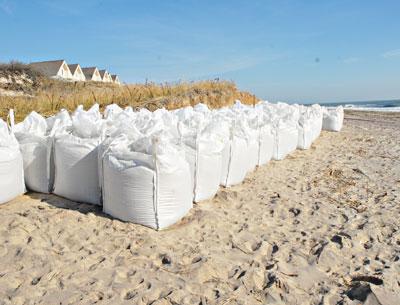Trustees Urge Caution

Two members of the East Hampton Town Trustees spoke at a town board meeting on Tuesday, expressing concerns that some property owners are taking advantage of an emergency permitting system — designed to allow for post-storm actions when houses or property are in imminent danger — to have work done that goes beyond that allowed under the town code, or what is needed on an emergency basis.
“Right now, we’ve got contractors and homeowners who think they’ve got carte blanche,” Diane McNally, the clerk of the trustees, told the town board. “We have projects that are taking away the public’s property, and have the potential to have long-term detrimental effects,” she said.
With permits for work along the coast usually required from both the trustees and from town agencies such as the Building or Natural Resources Departments, along with permission from the State Department of Environmental Conservation, Ms. McNally said that she feared property owners were not submitting their proposals — for repairs to stone armoring or beach replenishment, for instance — for review to all of the appropriate agencies, and that they might be getting mixed messages about what is allowed.
“We need to proceed forward according to the code that exists now. It was put in place to protect our shorelines,” she told the town board.
The town’s local waterfront revitalization plan, crafted over a number of years and approved by New York State, and other sections of the town code, as well as trustee regulations, govern what may or may not be done on shorelines. For example, no new “hard structures” to prevent coastal erosion, such as jetties or groins, may be placed on ocean shores, because of their deleterious effect on neighboring stretches of beach. In other areas, existing erosion-control devices may be repaired, but no new ones installed.
However, there have been several instances, post-Sandy, where those regulations have been ignored. Some members of the town board have questioned whether the rules are too strict, and a committee to review coastal regulations was recently appointed.
“We need to slow down a little bit, and ensure that the code is being followed,” Ms. McNally said Tuesday. “The storm was quite a few weeks ago,” she said, referring to Hurricane Sandy. “Right now, if your home is not being threatened . . . the beach will repair itself. It’s not an emergency.”
“Understand, the homeowner just wants to get it done,” said Supervisor Bill Wilkinson. “I also think, generically, that ‘imminent threat’ is a relative term.” The owner of a property where shorefront erosion has eaten away a significant portion of land will view that as an emergency, he said, fearing the impact of the next storm.
“It’s all perspective,” Ms. McNally said. “Unfortunately, the homeowners, they’re nervous,” said Stephanie Forsberg, also a town trustee. “And they’re right to be nervous. But then they take that, and move forward. . . .”
“That’s why we’re here — because we’re the voice of the public beach owners,” Ms. Forsberg told the supervisor. “Just like you’re speaking of the homeowner trying to get it done, we’re speaking for them,” she said.
The result, both trustees said, could be actions that damage the public beaches, which the trustees oversee for the public — except in Montauk, where they do not have jurisdiction.
Both Ms. McNally and Ms. Forsberg urged the town officials to avoid sending “mixed signals” to the public. “We need to be unified, going forward together,” Ms. Forsberg said, both on trustee, town, and private property. Although she acknowledged that the town has sole jurisdiction in Montauk (along with the state), the trustees are making decisions on applications for properties just a few miles away, on Napeague. One section of town should not be treated differently from another, she said.
For instance, she said, “We want to make sure that in Montauk things aren’t happening . . . that there are not hard structures going in that can make the beach worse,” or that, where sand is being added to build up beaches, that it is “beach-compatible” sand.
“The way the jurisdictions are set up, that’s quite possible that could happen, that we have a different opinion,” said Mr. Wilkinson.
“Are we going to have another generation with beach in front of it, or are we going to wind up with a situation like Mulford Lane [in Amagansett], where there’s no public beach?” Ms. McNally asked.
“We know hard structures, in the long term, are not the best solution,” said Councilwoman Sylvia Overby. She expressed concern about the trustees’ statement that illicit projects were adversely affecting public beach, and asked if enforcement efforts were under way. Ms. McNally said they were.
